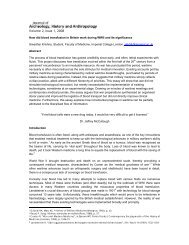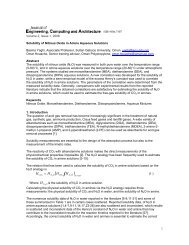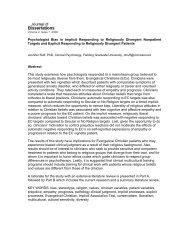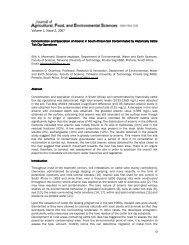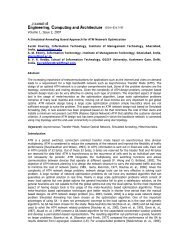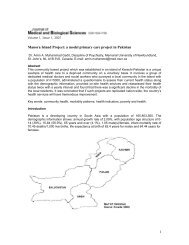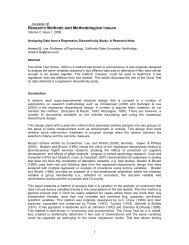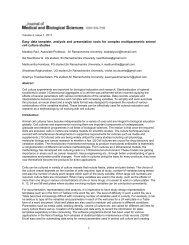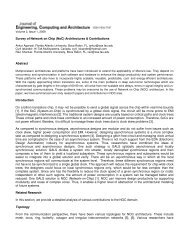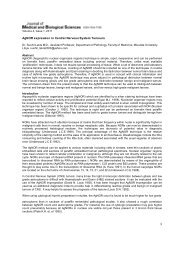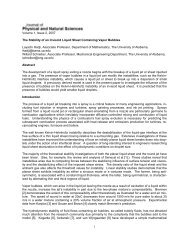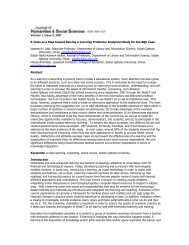The Heaven and Earth Society and the Red Turban Rebellion in ...
The Heaven and Earth Society and the Red Turban Rebellion in ...
The Heaven and Earth Society and the Red Turban Rebellion in ...
You also want an ePaper? Increase the reach of your titles
YUMPU automatically turns print PDFs into web optimized ePapers that Google loves.
tax dem<strong>and</strong>s could easily push people below <strong>the</strong> marg<strong>in</strong> of subsistence. <strong>The</strong>refore, government<br />
commutation of taxes was often a major dem<strong>and</strong> of <strong>the</strong> <strong>Red</strong> <strong>Turban</strong> rebels. Violence was already endemic<br />
to <strong>the</strong> Pearl River Delta.<br />
Second, local violence was fur<strong>the</strong>r aggravated by heavy-h<strong>and</strong>ed practices of <strong>the</strong> Q<strong>in</strong>g state on<br />
local Ti<strong>and</strong>ihui lodges who eventually became organizers <strong>and</strong> perpetrators of <strong>the</strong> <strong>Red</strong> <strong>Turban</strong> <strong>Rebellion</strong><br />
under <strong>the</strong> <strong>in</strong>itial leadership of Chen Song. While many of <strong>the</strong> <strong>in</strong>dividual outbreaks that collectively made up<br />
<strong>the</strong> <strong>Red</strong> <strong>Turban</strong> <strong>Rebellion</strong> were directly l<strong>in</strong>ked to events that threatened <strong>the</strong> livelihood of <strong>the</strong> people,<br />
subsistence crises alone do not provide an adequate explanation for <strong>the</strong>se rebellions. In <strong>the</strong> Pearl River<br />
Delta, <strong>the</strong> decision to rebel seems to have been made deliberately <strong>in</strong> almost every case.<br />
Most of <strong>the</strong> rebels did not rise up aga<strong>in</strong>st <strong>the</strong> government on <strong>the</strong> spur of <strong>the</strong> moment, as someone<br />
act<strong>in</strong>g out of bl<strong>in</strong>d fury would do. Both Chen Kai <strong>and</strong> Li Wenmao spent several months prepar<strong>in</strong>g for revolt<br />
under <strong>the</strong> leadership of Chen Song, <strong>and</strong> <strong>the</strong>ir upris<strong>in</strong>gs were both related to subsistence-threaten<strong>in</strong>g tax<br />
dem<strong>and</strong>s <strong>and</strong> to <strong>the</strong> Ti<strong>and</strong>ihui direction. 190 He Liu’s Ti<strong>and</strong>ihui lodge spent more than a year organiz<strong>in</strong>g to<br />
resist excessive tax dem<strong>and</strong>s related to commutation. 191 In o<strong>the</strong>r words, <strong>the</strong> ambitions of certa<strong>in</strong> Ti<strong>and</strong>ihui<br />
leaders <strong>in</strong>tensified <strong>and</strong> transformed local discontents <strong>in</strong>to massive rebellion aga<strong>in</strong>st <strong>the</strong> state.<br />
Third, although people of different ethnic groups <strong>and</strong> different social strata b<strong>and</strong>ed toge<strong>the</strong>r aga<strong>in</strong>st<br />
<strong>the</strong> Q<strong>in</strong>g government, <strong>the</strong> revolt, particularly <strong>in</strong> <strong>the</strong> wuyi regions, was caused largely by a pervasive<br />
subethnic hostility. At <strong>the</strong> low level of society, <strong>the</strong> Punti rebels <strong>in</strong> <strong>the</strong> wuyi regions tended to direct <strong>the</strong>ir<br />
hostility primarily at <strong>the</strong> Hakka people. <strong>The</strong> solidarity demonstrated by rebels of <strong>the</strong> Punti <strong>and</strong> by militias of<br />
<strong>the</strong> Hakka is one <strong>in</strong>terest<strong>in</strong>g f<strong>in</strong>d<strong>in</strong>g of this study. After <strong>the</strong> suppression of <strong>the</strong> <strong>Red</strong> <strong>Turban</strong> rebels, <strong>the</strong> Hakka-<br />
Punti armed conflicts cont<strong>in</strong>ued for more than ten years (1865-1867) <strong>and</strong> covered most of <strong>the</strong> wuyi regions<br />
along <strong>the</strong> Pearl River valley.<br />
Fourth, <strong>the</strong> <strong>Red</strong> <strong>Turban</strong> <strong>Rebellion</strong> had aga<strong>in</strong> realigned <strong>the</strong> power structure of <strong>the</strong> local Ch<strong>in</strong>ese<br />
communities, with <strong>the</strong> gentry emerg<strong>in</strong>g from <strong>the</strong> local disorder considerably streng<strong>the</strong>ned. What G. William<br />
Sk<strong>in</strong>ner has termed “community closure” began to take effect. 192 L<strong>in</strong>eages, subl<strong>in</strong>eages, <strong>and</strong> villages turned<br />
<strong>in</strong>ward for protection while competition <strong>and</strong> feud<strong>in</strong>g among <strong>the</strong> communities <strong>in</strong>tensified. Economy activity at<br />
<strong>the</strong> regional level <strong>and</strong> economic mobility became constricted; protective confederations <strong>and</strong> boundaries<br />
hardened. As magistrates hesitated to <strong>in</strong>terfere, as l<strong>in</strong>eage leaders were able to defy civil servants, <strong>and</strong> as<br />
disaffection with <strong>the</strong> government spread, Q<strong>in</strong>g governance became ever more superficial. Villagers took <strong>the</strong><br />
law <strong>in</strong>to <strong>the</strong>ir own h<strong>and</strong>s. In <strong>the</strong> 1850s dur<strong>in</strong>g <strong>the</strong> <strong>Red</strong> <strong>Turban</strong> <strong>Rebellion</strong>, <strong>the</strong> gentry obta<strong>in</strong>ed <strong>the</strong> legitimacy<br />
to reorganize regional militia, to have its own tax base to f<strong>in</strong>ance <strong>the</strong> militia, <strong>and</strong> to use <strong>the</strong> militia for regional<br />
hegemony.<br />
Last, <strong>the</strong> suppression of <strong>the</strong> <strong>Red</strong> <strong>Turban</strong> <strong>Rebellion</strong> with <strong>the</strong> aid of foreign troops was not only a<br />
brutal <strong>and</strong> devastat<strong>in</strong>g, but also a shortsighted political action. <strong>The</strong> human <strong>and</strong> material destruction was<br />
immense <strong>and</strong> <strong>in</strong>calculable, sow<strong>in</strong>g profound seed of bitterness <strong>and</strong> xenophobia <strong>in</strong> <strong>the</strong> m<strong>in</strong>ds of survivors.<br />
Thous<strong>and</strong>s had been driven from <strong>the</strong>ir homes <strong>and</strong> deprived of <strong>the</strong>ir livelihood, while o<strong>the</strong>rs emigrated<br />
abroad, some as <strong>in</strong>dentured laborers <strong>in</strong> <strong>the</strong> Americas. In addition to hundreds of villages, some thirty-two<br />
different adm<strong>in</strong>istrative seats <strong>in</strong> Guangdong rang<strong>in</strong>g from <strong>the</strong> district to <strong>the</strong> prefectural level were lost to <strong>the</strong><br />
<strong>in</strong>surgents dur<strong>in</strong>g <strong>the</strong> period of 1854 to 1855. Most were quickly recaptured, but several were held by <strong>the</strong><br />
rebels cont<strong>in</strong>uously for more than several years. For example, Deq<strong>in</strong>gzhou <strong>in</strong> Zhaoq<strong>in</strong>g county was held by<br />
<strong>the</strong> rebels until April 1858. 193 <strong>The</strong> prov<strong>in</strong>cial capital never fell, but it came perilously close on two occasions.<br />
Towns were reduced to rubble, fields were overgrown with weeds, <strong>and</strong> large tracts of <strong>the</strong> prov<strong>in</strong>ce were<br />
depopulated. 194<br />
190 Foshan Zhongyi xiangzhi, 11.14-15; “Chen Song Shiyou,” <strong>in</strong> Hongb<strong>in</strong>g Qiyi, 212-213.<br />
191 He Liu organized <strong>the</strong> Ti<strong>and</strong>ihui <strong>in</strong> his area for at least a year before he was pushed <strong>in</strong>to large-scale,<br />
active rebellion. See “He Liu deng shilong qishi yuanyou 何 六 等 石 龙 起 事 缘 由 ,” <strong>in</strong> Hongb<strong>in</strong>g Qiyi, 214.<br />
192 G. W. Sk<strong>in</strong>ner, “Ch<strong>in</strong>ese Peasants <strong>and</strong> <strong>the</strong> Closed Community: An Open <strong>and</strong> Shut Case,” <strong>in</strong><br />
Comparative Studies <strong>in</strong> <strong>Society</strong> <strong>and</strong> History, 13 (1971): 270-281.<br />
193 Jangkun Yoo 유장근, Kundae Zoongkuk’yi Bimil kyulsa 근대중국의 비밀결사, (Seoul: Koryowon,<br />
1996), 279.<br />
194 <strong>The</strong> devastation <strong>in</strong> <strong>the</strong> Pearl River Delta, <strong>in</strong>clud<strong>in</strong>g <strong>the</strong> burn<strong>in</strong>g of numerous houses, was not caused by<br />
<strong>the</strong> rebels alone, but by <strong>the</strong> imperial troops <strong>and</strong> local militias as well. <strong>The</strong> liv<strong>in</strong>g of many of <strong>the</strong> displaced<br />
refugees were lost not only through <strong>the</strong> fight<strong>in</strong>g, but through hunger, pestilence, <strong>and</strong> o<strong>the</strong>r tragedies as well.<br />
<strong>The</strong> <strong>Red</strong> <strong>Turban</strong> advance meant war, <strong>and</strong> war meant <strong>the</strong> destruction of crops, <strong>the</strong> disruption of trade routes,<br />
29



